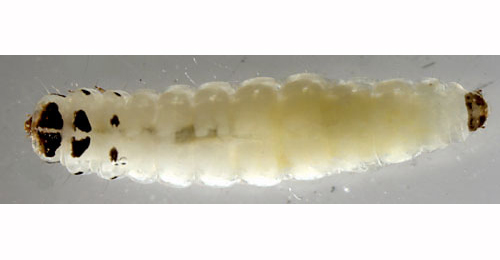|
||||||
|
Coleophora
lineolea (Haworth, 1828) Woundwort Case-bearer Porrectaria
lineolea
Haworth,
1828. Lep. Brit.:
534. |
||||||||||||||||||||||||||||||||||||||||||||||||||||||||||||||||||||||||||||||||||||||||||||||||||||||||||||||||||||||||||||||||||||||||||||||||||||||||||
|
Leaf-miner and case-bearer: The mines are large and obvious on the upper side of the leaf, betraying the larva or larvae on the lower side (UKMoths). Cases are broad and flat - being very hairy from the texture of the leaf (British leafminers). Immediately after emergence the larva makes a full depth, quickly widening, corridor, with frass as small grains in a broad central band. Finally results in a blotch of 2 x 5 mm, from which the young case is cut. The fully developed case is a hairy, greyish brown to silver grey lobe case case of about 1 cm long, with a clearly laterally compressed end; the mouth angle is about 90°. The case is difficult to separate from that of C. ochripennella (Bladmineerders van Europa). The case is illustrated in the Encyclopedia of Life. Larva: The larvae of moths have a head capsule and chewing mouthparts with opposable mandibles (see video of a gracillarid larva feeding), six thoracic legs and abdominal legs (see examples). The larva is illustrated in Bladmineerders van Europa.
Pupa: The pupae of moths have visible head appendages, wings and legs which lie in sheaths (see examples). Adult: The adult is illustrated in UKMoths. The species is included in mothdissection.co.uk. Comments: Stachys officinalis is treated as Betonica officinalis (Betony) by Stace (2010). Hosts in Great Britain and Ireland:
Hosts elsewhere:
Time of year - larvae: September to May (British leafminers). Time of year - adults: Flight period is from late June to August, sometimes coming to light (UKMoths). Distribution in Great Britain and Ireland: The species is common in southern England and Wales, but it becomes scarce and local in Chester and from south York to the northern limit of England (UKMoths); including Bedfordshire, Caernarvonshire, Cambridgeshire, Denbighshire, Dorset, Durham, East Cornwall, East Kent, East Norfolk, East Suffolk, Flintshire, Glamorgan, Herefordshire, Hertfordshire, Huntingdonshire, Isle of Wight, Leicestershire, Middlesex, North Essex, North Hampshire, North Somerset, Nottinghamshire, Shropshire, South Devon, South Northumberland, South-west Yorkshire, Surrey, West Cornwall, West Gloucestershire, West Norfolk, West Suffolk and Worcestershire (NBN Atlas). Distribution elsewhere: Widespread in continental Europe including Austria, Belgium, Crete, Croatia, Czech Republic, Danish mainland, Estonia, French mainland, Germany, Greek mainland, Hungary, Italian mainland, Latvia, Lithuania, Macedonia, North Aegean Is., Poland, Romania, Russia - Central, Sicily, Slovakia, Slovenia, Spanish mainland, Sweden, Switzerland and The Netherlands. Also East Palaearctic and North Africa (Fauna Europaea). NBN Atlas links to known host species:
British and Irish Parasitoids in Britain and elsewhere:
|
||||||||||||||||||||||||||||||||||||||||||||||||||||||||||||||||||||||||||||||||||||||||||||||||||||||||||||||||||||||||||||||||||||||||||||||||||||||||||
| Last updated 11-Jul-2019 Brian Pitkin | ||

